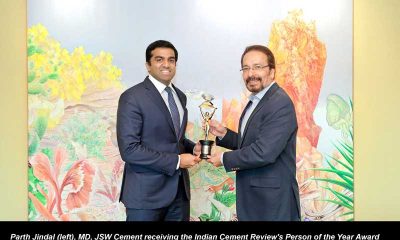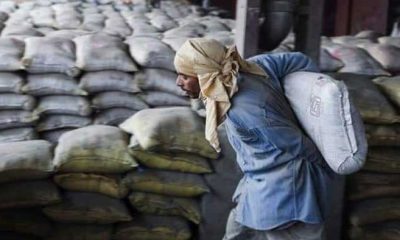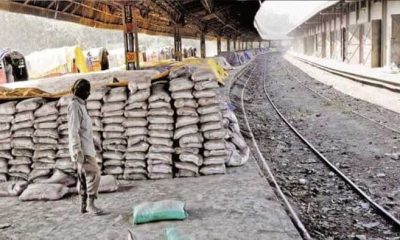Technology
Roller press is well-accepted technology in India
Published
2 years agoon
By
admin
With the focus of industry towards WHR systems, roller press grinding has further got acceptance as it uses no water for bed stabilisation and uses minimum hot gases as compared to other contemporary technologies, explains A K Dembla, President & Managing Director, Humboldt Wedag India.
With the focus of industry towards WHR systems, roller press grinding has further got acceptance as it uses no water for bed stabilisation and uses minimum hot gases as compared to other contemporary technologies, explains A K Dembla, President & Managing Director, Humboldt Wedag India.
Today, the requirement for the cement industry is to reduce the use of energy in the grinding process and make it more efficient. Please share your views on how this can be achieved.
Grinding constitutes about 65-70 percent of the electrical energy consumption of cement manufacturing, any saving in grinding energy can be good for operating cost reduction. The energy cost is also increasing with time; therefore, cement manufacturing companies are looking for new technologies for low electrical energy consumption. Machinery manufacturers are putting a lot of R & D efforts in the grinding process to reduce electrical energy consumption in the cement industry which also helps in reduction in carbon footprints.
What is the latest energy-efficient grinding technologies/solution? What benefits cement companies can achieve in terms of energy consumption, quality, cost, etc?
The latest development related to raw materials grinding in finish grinding in Roller Press has paid dividends even for soft and medium to hard material. Hard raw materials are giving a higher bonus factor in finish grinding roller press systems and cement manufactures are getting 2-4 Kwh/t saving in electrical energy in raw material grinding itself by using this technology as compared to Vertical Mill technology. KHD has supplied 33 raw material grinding circuits in the last 10 years up to 10,000 tpd capacity plants. Typical circuit offered by KHD for raw materials grinding in ComFlex Grinding circuit has advantages to process raw materials with high moistures with the incorporation of V-Separator below the roller press and use of hot gases to dry the raw materials. With the focus of industry towards WHR systems, roller press grinding has further got acceptance as it uses no water for bed stabilisation and uses minimum hot gases as compared to other contemporary technologies.
In the case of cement grinding, again two technologies are being accepted –Vertical Roller Mill or Roller Press in semi-finish or finish grinding. Roller Press in finish grinding has the advantage of further saving of 3-4 Kwh/t as compared to Semi-finish grinding and Vertical Mill technology. With more acceptance of blended cement like PPC, PSC, and composite cement, roller press in finish grinding is accepted as advanced technology in cement grinding. KHD has sold 75 Cement Grinding Circuits in the last 10 years because of the need to save electrical energy. Typical Finish & Semi-finish Grinding circuits offered by KHD are very popular in the cement industry that includes the use of Roller Press alone or in a combination of Roller Press & Ball Mill respectively.
In the case of Slag grinding, the acceptance of roller press in finish grinding is well recognised. It offers the distinct advantage of saving of about 6-7 Kwh/t as compared to Vertical Roller Mill at 4200 Blaine. KHD has sold 27 Sag Grinding Circuits and maintains about 70 % market share in slag grinding in India. The advantage comes due to the hardness of Slag and pressure grinding in roller press instead of attrition and low pressure in Vertical Roller Press. Moisture issue is also tackled with the problem of coating by incorporating V-separator below roller press.
The most important properties of cement are strength and workability. This could be achieved by modifying the grinding equipment. Please share your views. What grinding technique/equipment can be used to ensure strength and workability?
Strength and workability are two important parameters for cement when it is used as binding material in the form of concrete. Workability is one of the physical parameters of concrete which affects the strength and durability and can be defined as the ease with which the concrete can be mixed, placed, compacted, and finished. Concrete is said to be workable when it is easily placed and compacted homogenously i.e without bleeding or segregation. Technically speaking, workable concrete is the amount of useful internal work necessary to produce 100 percent compaction. Wet concrete is more workable than dry concrete and is a function of particle size distribution and water demand during the application of concrete in construction work. In this context 1 day, 3 days, and 7 days strength is important.
Similarly, the strength of cement depends upon the particle size distribution in cement which is achieved through a suitable grinding process and separator. Normally 3-32 micron size offers maximum strength and it should be in the range of 70-80 percent in cement. This range was established by conventional grinding in 2 chambers ball mill before acceptance of newer technology like Vertical Mill Roller Press technology. Semi-finish grinding in roller press has ball Mill along with roller press and therefore offers best particle size distribution (comparable to ball mill product). However, in the case of roller press in finish grinding and Vertical Mill, particle size distribution is steeper which is corrected through a high-efficiency separator. Also, with the advent of blended cement, the concept of particles in the range of 3-32 microns has also got diluted.
Two-compartment ball mills and air separators used to be the main process equipment in clinker grinding circuits. How has been the evolution in terms of technical innovations in this area?
Two compartments ball mill with separator has been conventional cement grinding technology which is still existing in many countries where electrical energy costs are low. Subsequent developments like the use of Roller Press and Vertical Mill offers saving of 5-10 Kwh/t electrical energy consumption for a typical 3200 Blaine cement as compared to a ball mill.
Ball mill technology has also gone through innovations in terms of various modified impact liners, classifying liners, and flow control diaphragms. But these modifications have the potential of limited savings in the range of 1-2 Kwh/t as compared to conventional liners and diaphragms.
Separators have also gone through various technological developments, and we are offering 4th generation high-efficiency separators nowadays. These separators offer a sharp cut point and minimum bypass (particle below 3 microns).
The usage of cement additive materials is on a rise. Please share your views on the same. What kind of grinding aids are in demand and what are the advantages?
Grinding aid or grinding additives are materials, which are added with raw mix while grinding the cement in either a ball mill or vertical roller mill to reduce the agglomeration of cement particles by neutralising the static charges and increasing the rate of size reduction to improve the throughput and performance of the cement. Grinding aids are mainly of two types-
a) Strength Enhancer which is used to increase the mechanical strength by chemical activation, without changing the cement surface and particle size distribution. Alkanolamines are frequently used and can increase the compressive strength (at different or all ages) by max. five MPa. These admixtures increase the productivity of the grinding aid at the same time.
b) Performance Enhancers which are supplementary cementitious materials such as granulated blast furnace slag, natural Pozzolanic, and fly ash to reduce CO2 emissions and material cost. However, supplementary cementitious materials may counteract strength development, powder flowability, mortar workability, and durability, which are critical for cement quality. Generally, the grinding aids can be Amine-based or Alcohol Based, or Ethyl Based Grinding Aids. Overall benefits include enhanced production process and the quality of cement, improved powder followability, strength development, mortar workability, and durability, adjusting the cement quality to meet the demands set by relevant standards and cement customers. Above all, it ensures less environmental impact by reducing utilisation of energy and resources combined with minimised carbon footprint.

Please share your roadmap in the grinding technology area.
At present focus is to use Roller Press in finish grinding to get maximum energy advantage as compared to Ball Mill Grinding especially for blended cement. Apart from electrical energy focus is also on the Roller Press surface which has minimum wear and offers trouble and maintenance-free operation. Stud technology has proven a boon for the industry in this area, Tungsten Carbide Studs are fixed on the roller surface by pressing in pre-drilled rollers which offer autogenous grinding and minimum wear. Life expected out of these roller surfaces varies from 25000-40000 hours of operations without any surface maintenance. Fig 2 gives a picture of the stud surface roller. Apart from this, developments are on optimising the process circuit for energy efficiency & pollution-free operation. Developments in actuated dosing gate for feeding material to Roller press and online monitoring of roller press surface are also worth noticing.
You may like
Economy & Market
We are shaping the future of clean air
Published
3 days agoon
April 16, 2024By
admin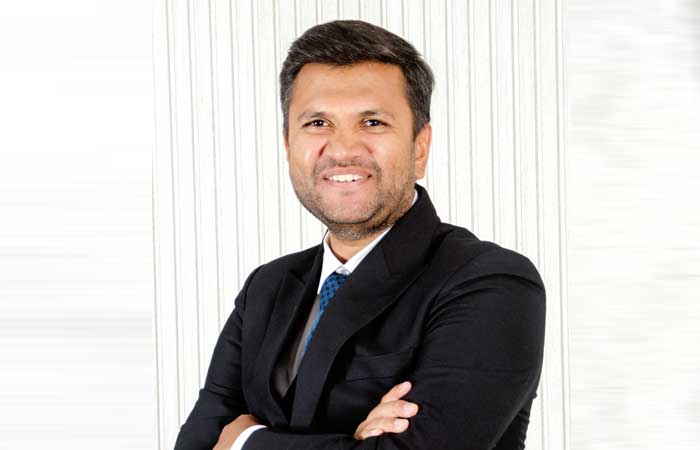
Monil Parikh, Managing Director, Techflow Enterprises Pvt Ltd, leads us to a better understanding of how cutting-edge designs and advanced technologies are revolutionising the process of filtration, driving efficiency and environmental responsibility within the cement sector.
Tell us about your air pollution control systems.
Techflow Enterprises, operating from our expansive 30,000 sq m facility, which is one of India’s largest, manufactures a comprehensive suite of air pollution control systems specifically designed for cement plants. Our solutions include:
Pulse Jet Bag Filters: Employing compressed air for efficient cleaning, these capture fine dust particles generated during grinding and packing. Techflow’s bag filters are designed to restrict the outlet emission up to 5mg/Nm3.
Electrostatic Precipitators (ESPs): Ideal for ultra-fine particulate matter in kiln exhaust gases, ESPs utilise an electric field for superior dust capture with 99.9 per cent capacity.
Centrifugal Fans: We offer various fans like induced draft (ID) fans for draft creation, process fans for dust-laden air transport, and kiln fans for high-temperature gas streams.
Techflow’s commitment to quality is evident in our proven track record. We are actively supplying solutions to leading cement players like Adani Cements, Ambuja and ACC Cement, Dalmia Bharat Cement and Wonder Cement. Our installations across India and Asia stand as a testament to our expertise in handling cement plant dust control challenges.
How do your products and systems integrate with cement plants?
Techflow’s air pollution control systems seamlessly integrate into your existing cement plant. Our pulse jet bag filters fit effortlessly downstream of grinding mills and packing stations, effectively capturing fine dust particles generated during these processes. Electrostatic Precipitators (ESPs) excel in kiln exit gas streams, working alongside existing cyclones to achieve ultra-fine particulate control, a critical step in maintaining clean air emissions.
Techflow’s comprehensive offering of centrifugal fans ensures a perfect fit for any application. Our ID fans seamlessly integrate into the kiln system, creating the necessary draft to pull exhaust gases through the air pollution control equipment. Process fans, strategically placed throughout the plant, efficiently convey dust-laden air from various generation points, like clinker coolers and raw material handling, towards the filtration units. This modular approach minimises disruption during installation and ensures optimal dust collection across your entire cement production process.
How do your innovative designs better the process of filtration at cement plants bringing efficiency to the process?
Techflow’s commitment to innovation translates to superior filtration efficiency and operational cost savings for cement plants. Our pulse jet bag filters incorporate features like:
- High-efficiency filter media: Designed for specific dust types, this media minimises pressure drop across the filter, reducing energy consumption.
- Improved flue gas entry design
- Low Pressure Cleaning Systems
- Optimised pulse cleaning systems: These systems efficiently dislodge dust cake buildup using compressed air, maximising filter media life, and minimising downtime.
Our ESPs utilise advanced electrode designs to enhance particle collection and reduce maintenance intervals. Furthermore, Techflow’s centrifugal fans are meticulously crafted for superior aerodynamic performance, leading to lower energy consumption and improved overall plant efficiency.
Techflow has developed a SMART-LINK automation module for better maintenance and real-time remote tracking of performance of each equipment. Cement plants equipped with Techflow’s systems experience reduced operational costs, minimised downtime and compliance with ever-evolving environmental regulations.
What is the key differentiator between traditional filters and modern filters?
Traditional bag filter systems often relied on manual cleaning methods, leading to inconsistent performance, increased downtime, and potential worker exposure to dust. Modern pulse jet bag filters, like those offered by Techflow, address these limitations.
Our systems leverage automated cleaning mechanisms, ensuring consistent filtration efficiency and minimal operator intervention. Additionally, advanced filter media materials in Techflow’s bag filters offer superior dust capture capabilities compared to traditional fabric filters.
This commitment to modern technology translates to a safer and more efficient and environmentally friendly dust control solution for cement plants.
Can your designs be customised as per the requirement of the customers?
At Techflow, we understand that every cement plant has unique dust control requirements. That is why we prioritise customisation across our entire product range:
Pulse Jet Bag Filters: Filter media type and micron rating based on dust properties, number of filter bags, and pulse cleaning system configuration like cycle time and pressure can all be adjusted to optimise performance for your specific dust and airflow. The system can be designed to achieve less than 5mg/Nm3 outlet emission standards as well.
- Electrostatic Precipitators (ESP): ESP design can be customised with features like the number of electrode rows, electrode spacing, and power input like voltage and current to achieve the desired dust collection efficiency for your specific outlet emission capacity less than 20mg/Nm3.
- Centrifugal Fans: Fan designs are tailored by adjusting factors like impeller diameter, blade design, and motor size to meet the specific pressure and flow requirements of various processes within a cement plant.
This focus on customisation ensures Techflow’s air pollution control systems perfectly match your cement plant’s needs, guaranteeing optimal dust capture and efficient operation.
What is the role of technology and automation in building filtration systems?
Techflow has designed a SMART-LINK System that can be integrated to our equipment which tracks and monitors performance of equipment in real time.
- Continuous diagnostics
- Condition-based maintenance
- Prevention of unplanned downtime
- Early problem detection using AI
- Data collection for process optimisation and efficiency maximisation
- Auto alert with warning driving timely human interactions
- Remote maintenance assistance by Techflow Team.
What are the major challenges in the filtration process and your system integration at cement plants?
The cement industry’s focus on sustainability, higher production and diverse fuel sources creates filtration hurdles. Adapting to changing dust properties, handling increased dust loads, and integrating seamlessly within space constraints are key challenges.
Techflow tackles these issues through advanced design techniques, exploration of innovative filter media, and modular system design. This ensures our filtration systems remain adaptable, efficient and seamlessly integrated within your cement plant, empowering your success.
How do you plan to further better your products and bring innovation in the future?
At Techflow, we are not just building filtration systems, we are shaping the future of clean air in the Indian cement industry. After successful expansion of the manufacturing facility in 2023, now it is time to improve designs and process optimisation. The future holds exciting possibilities: next-generation filter media with self-cleaning properties and
extended lifespans, minimising maintenance and maximising efficiency.
Techflow’s legendary after-sales support is about to get even better. We are expanding our global service network to provide you with 24/7 access to a team of India’s most experienced filtration specialists, ensuring your system operates flawlessly throughout its lifecycle.
Together, we will lead the way towards a sustainable future, paving the path for a greener tomorrow with green cement.
- –Kanika Mathur
Economy & Market
Digitalisation is changing the logistics landscape
Published
3 days agoon
April 16, 2024By
admin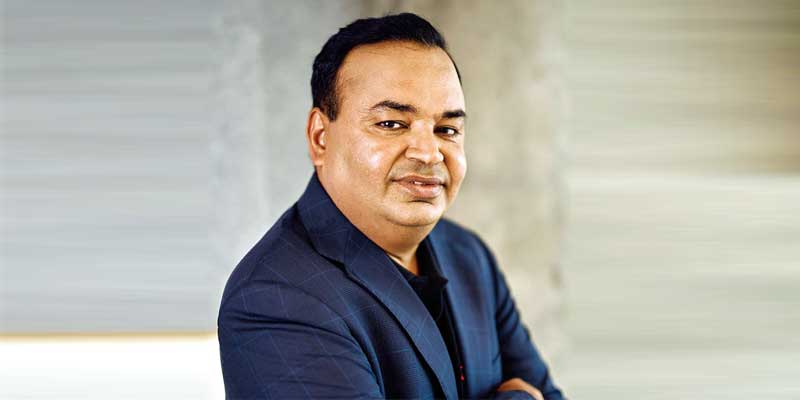
Haresh Calcuttawala, CEO and Co-Founder, Trezix, explains how their platform streamlines export processes, optimises logistics operations, and addresses the challenges faced by the cement industry.
How does your platform help in the compliance of cement exports?
The Trezix platform helps with the end-to-end processes for exporters, ensuring complete visibility of these processes focusing on shipments, documents, compliances, etc. The platform is also integrated with various stakeholders’ part of the export process including integration with Unified Logistics Integration Platform (ULIP) by the Government of India.
What is the impact of your systems on the cost and productivity of a cement plant?
The Trezix platform helps to optimise the turnaround time, visibility of shipment and improving efficiencies, which results in optimisation in logistics cost and improvement in working capital.
What are the major challenges in logistics and how can that be resolved?
A major challenge in the cement industry is the logistics cost and time for delivery. This can only be resolved with faster turnaround time, complete visibility of shipments, delivery lead time and process control to adhere to compliance.
Tell us your views on the change technology is bringing to logistics.
In the cement industry, so far technology has been more focused on internal process, and optimising demand and supply in the area of supply chain. However, now the focus has completely shifted to external stakeholders and their processes, and how have we integrated processes to further optimise the logistics execution.
Can your systems and solutions be customised based on customer requirements?
Every customer has some unique value proposition for their customer segment. Trezix has flexibility by way of configuration to adhere to industry needs and specific customer needs, keeping in mind the regulatory processes are not deviated to fulfil statutory requirements.
How do you foresee the face of logistics changing for the cement industry?
Digitalisation is one of the biggest waves you can see in the logistics space, which is changing the face of the industry. Digitalisation is changing the logistics landscape. Various concepts like Just In Time (JIT) to customer delivery are now a reality. Vehicle utilisation, fuel efficiency, delivery visibility, vehicle tracking through RFID, Fastag, FOIS (rail receipt tracking), container/cargo tracking across geography is now a reality.
- –Kanika Mathur

Ankit Kumar, Co-Founder and CEO, Skye Air, highlights the advantages of drone deliveries for the cement industry to improve the overall operational efficiency and cost-effectiveness of the supply chain.
What is the environmental impact that drone deliveries can create?
Drone deliveries have the potential to significantly reduce environmental impact compared to conventional delivery methods. By utilising drones, the carbon footprint of last-mile delivery can be slashed by eliminating the need for vehicles and vans, which emit greenhouse gases during transport. In fact, studies have shown that drone deliveries can reduce carbon emissions by up to 80 per cent compared to traditional delivery methods. Additionally, drones provide more direct routes, minimising congestion and further lowering emissions.
Furthermore, Skye Air’s implementation of drone technology can contribute to a substantial decrease in air pollution. Traditional delivery vehicles, powered by fossil fuels, contribute significantly to air pollution, whereas drones operate on cleaner energy sources, such as electricity. As a result, the adoption of drone technology by Skye Air could lead to a notable reduction in harmful pollutants released into the atmosphere.
It’s worth noting that Skye Air is committed to continuous monitoring and optimisation of its operations to ensure that the environmental benefits of drone delivery are maximised. Through data-driven analysis and innovative strategies, Skye Air aims to further enhance the efficiency and sustainability of its drone delivery services.
In conclusion, while drone deliveries offer significant environmental benefits, rigorous management and innovation are essential to mitigate any potential negative effects and ensure the long-term viability of drone delivery operations.
Tell us about the efficiency created by drone delivery systems.
Skye Air has spearheaded a paradigm shift in the logistics industry by substantially augmenting efficiency in their drone deliveries. Drones can help circumvent traditional road networks, bypass traffic congestion and surmount logistical impediments, facilitating expeditious and direct transportation of goods. This heightened efficiency is particularly conspicuous in exigent circumstances, such as the delivery of medical supplies to remote regions or the expeditious fulfillment of urgent orders. By harnessing the capabilities of drones, Skye Air optimises delivery routes, curtails fuel consumption, and mitigates the overall operational costs inherent in conventional delivery methodologies.
Indeed, empirical data underscores the efficacy of drone deliveries, showcasing a significant reduction in delivery times by up to 50 per cent compared to traditional methods. Moreover, drone deliveries have been shown to minimise fuel usage by approximately 60 per cent, contributing to substantial environmental conservation efforts.
Furthermore, the automation of the delivery process not only expedites operations but also bolsters efficiency, resulting in enhanced customer satisfaction rates. With streamlined processes and expedited turnaround times, Skye Air sets a new standard for excellence in the logistics domain.
What is the role of digitalisation and technology in your delivery and transport system?
In Skye Air, digitalisation and technology serve as pivotal catalysts in revolutionising our delivery and transport system. Through the integration of cutting-edge drone technology like Skye UTM, we have established a streamlined and efficient delivery process. Our drones are equipped with state-of-the-art navigation systems and sensors, enabling precise and secure delivery routes. Skye UTM stands as the most advanced and indigenised Aerial Traffic Management platform, designed to furnish situational awareness, autonomous navigation, risk assessment, and traffic management to all drone and aerial mobility operators across the airspace. Skye UTM has already facilitated successful BVLOS (Beyond Visual Line of Sight) drone flights. The Skye UTM captures over 255+ parameters of UAV movements, storing them in its ‘Black box’, which comprises a published systematic description of the entire flight. This platform offers the inaugural 3-Dimensional view of the drone airspace, alongside operations and regulations mapping servers, furnishing the latest airspace status, verified paths, and exhibiting real-time UAV movements. Furthermore, our digital platforms empower customers to seamlessly place orders and track their deliveries in real-time. This digitalisation not only amplifies the velocity and precision of our deliveries but also ensures transparency and accountability throughout the entire process.
Can drone deliveries be incorporated with the cement industry in the future?
In the foreseeable future, the incorporation of drone deliveries holds promise for integration within the cement industry, presenting efficient and swift transportation solutions for materials. The sophisticated drone technology prevalent in logistics stands poised to collaborate seamlessly with cement companies, optimising their supply chain operations. Drones can ferry small batches of cement or other construction materials to remote or challenging-to-access locations, thereby diminishing reliance on conventional transportation modes such as trucks and mitigating logistical complexities. Through the strategic utilisation of drones, the cement industry stands to bolster its efficiency, curtail costs and elevate overall operational efficacy.
- –Kanika Mathur

RAHSTA will drive road construction innovation: Sundaresan

New appointment at TMEIC

Social Impact Award for Ambuja Cements

UCWL unveils new plant in Dabok, Udaipur

Ambuja Cement hosts ‘Watershed’ event

Environment Ministry revises rules of solid waste management

M-sand boards new terrain

Process and quality optimization in cement plant.
Concrete: A Highly Sustainable Building Material




